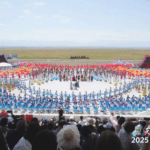By: Shelley Montgomary
In a time when many of us are longing for deeper connection but unsure how to navigate the emotional terrain of modern relationships, The Dance of Love by Ann O’Brien arrives as a grounding force. Drawing from her background in Aikido—a martial art rooted in harmony and energy redirection—O’Brien reveals a powerful path for staying centered in conflict, sustaining passion, and embodying both strength and sensitivity. In this third conversation, we dive into how Aikido’s principles apply not just to the dojo but to the everyday dance of intimacy, personal growth, and real emotional engagement.
The Power of Staying Centered
In emotionally charged moments, being centered can feel like a superpower. O’Brien describes it as the ability to stay in touch with your own energy, thoughts, and feelings—even when someone else’s reality is very different.
The book offers practical guidance on how to achieve this centeredness. Using postural techniques, breath awareness, and real-life relational examples, O’Brien shows how staying grounded helps us relate more effectively with all kinds of people and situations.
“Being centered means you retain your own power no matter what is going on around you,” she writes. “It means you don’t get overwhelmed by intense situations or energies.”
Aikido: A Somatic Model for Love
The Dance of Love weaves Aikido’s principles seamlessly into relationship guidance. Far from abstract theory, Aikido offers actionable tools that help us navigate emotional conflict and power dynamics.
Techniques include:
- Reflection & Integration. Our actions resonate and evolve both internally and relationally.
- Timing & Conditional Alignment. Catch the right moment to move.
- Harmony & Blending. Reacting with openness turns clashes into choreography of connection rather than confrontation.
- Centering & Grounding. Grounding yourself emotionally and spiritually enables greater resilience, clarity, and sensitivity.
This somatic lens helps us shift from reactive patterns—fight, flight, freeze—to presence, movement, and relational flow.
Assertiveness and Responsiveness: A Dynamic Dance
One of the book’s central teachings is how to balance two essential relational skills:
- Healthy assertiveness (a masculine trait): initiating, guiding, and offering direction with love and clarity.
- Attuned responsiveness (a feminine trait): feeling, sensing, and reacting to what’s really happening—not just what we fear or expect.
Mastering this balance creates mutual respect and deep connection. It empowers both partners to show up fully and engage consciously.
Overcoming Numbness and Resignation
In today’s hyper-digital world, many people fall into disconnection without realizing it. O’Brien warns of the dangers of numbness and resignation, and offers grounded advice for staying emotionally alive:
“Get off the screens sometimes! Whether or not you practice Aikido, find a mind-body discipline, and spend time in a real-life community. Commit to people and practices long enough to be called into your full self.”
Centering Amid Conflict
To love well, we must remain centered—even when emotions run high. O’Brien describes being centered as staying connected to your own energy, thoughts, and truth, regardless of the intensity around you.
Through specific Aikido-based positioning and awareness practices, readers learn to stay grounded under relational pressure. Real-life stories make these practices accessible and relatable, showing how to remain open without collapsing and staying strong without shutting down.
Personal Insights and Relational Transformation
O’Brien shares her own journey with raw honesty. She admits to patterns of freezing and over-functioning—traits many readers will relate to. By shifting from reactivity to accurate responsiveness, she has experienced profound relational shifts.
One of her favorite practices? Asking:
“What would love do?”
This simple question, rooted in the Aikido principle of Ai (love/harmony), reconnects her to a larger wisdom. It moves her out of the small self and into a relationship with something greater—conserving energy and inviting clarity.
One Sentence That Captures It All
If The Dance of Love could be summarized in a single sentence, O’Brien offers this:
“Remember your infinite nature and join with other people as that you.”
To apply this today?
Get quiet. Reflect. Ask your higher self for one step you can take to embody that truth right now.
Whether you’re new to relationship work or deep on the path, The Dance of Love is a guidebook for the heart, body, and soul. It offers timeless wisdom for modern love—full of practical tools, embodied practices, and spiritual insight.
Ready to live your own dance of love? This book will show you how.
Disclaimer: The information provided in this article is for general informational purposes only. The article is not intended to replace consultation with a licensed therapist, relationship expert, or professional coach. Ann O’Brien’s approach to love and relationships, as presented in The Dance of Love, is based on personal experience and the principles of Aikido. Readers are encouraged to seek professional advice and guidance as needed.

















